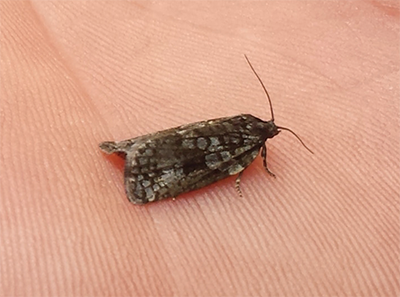
Modeling Spruce Budworm Dispersal and Disturbance
Dr. Brian Sturtevant of the USFS will be presenting his talk on “Process-based Modeling of Spruce Budworm Dispersal and Disturbance” as part of the Barbara Wheatland Seminar Series on Friday, October 12, at 3pm in Nutting Hall.
Seminar Abstract
The spruce budworm outbreak raging in Quebec is now literally at Maine’s doorstep. Spruce budworm is among the most studied insects in the world, and yet much uncertainty remains in terms of the timing of outbreak expansion in Maine, its anticipated duration, and consequent impacts. In this seminar, I overview progress on collaborative US-Canadian Forest Service development in budworm outbreak modelling at two very different temporal scales. The first simulates day to day mass exodus dispersal behavior of spruce budworm moths via wind currents. The biologically-based and meteorologically-conditioned budworm flight model holds promise as an operational tool for assessing budworm outbreak events, with the potential to inform both land management agencies and a concerned public as the eastern North American outbreak shifts into more human-dominated regions of the southeastern boreal and Acadian forests. Second, we designed a population-based spruce budworm disturbance extension for a landscape disturbance and succession model (LANDIS-II) that represents a modern synthesis of past scientific paradigms. Two levels of reciprocal feedback, one for the budworm and its host tree, and one for the budworm and its natural enemies, generate the temporal dynamic, while the combination of multi-scaled dispersal (i.e., local larval dispersal and long-distance adult dispersal) and spatially auto-correlated weather perturbations generate the spatial dynamic. Simulated outbreak behavior shares spatiotemporal patterns we have observed within outbreaks of both spruce budworm and the forest tent caterpillar in the Border Lakes region of Minnesota and Ontario, but significant work remains to scale-up the behavior of small 16x16km (10×10 mi) landscapes to actual landscapes. I’ll conclude with our validation and application plans for the state of Maine.
Speaker Bio
Dr. Brian Sturtevant is a Research (Landscape) Ecologist with Northern Research Station of the US Forest Service, working out of the Institute for Applied Ecosystem Studies in Rhinelander, Wisconsin for the past 17 years. He earned a B.S. in Natural Resources Management from Rutgers University (1992), an M.S. in Wildlife Ecology from Utah State University (1996), and a Ph.D. in Ecology from the University of Maryland (2001). His expertise lies in broad-scale interdisciplinary investigations of forest dynamics and disturbance ecology, with an emphasis on fire and insect disturbance, using a combination of field study, analyses of spatial datasets, and landscape simulation modeling. He also serves on the advisory board and technical committee for the landscape disturbance and succession model, LANDIS-II.
